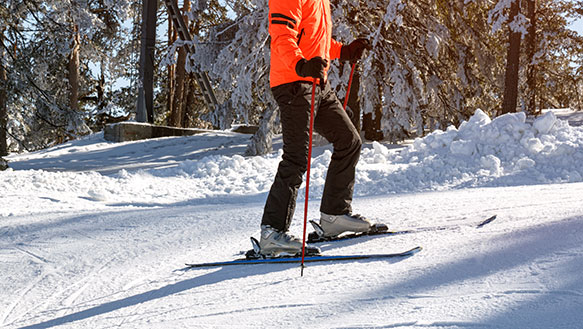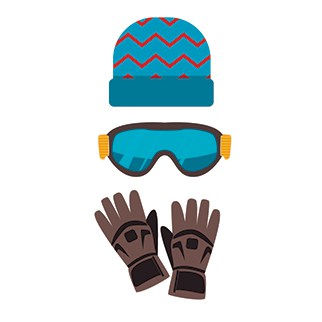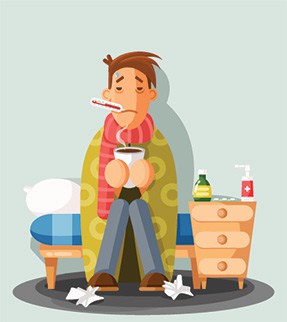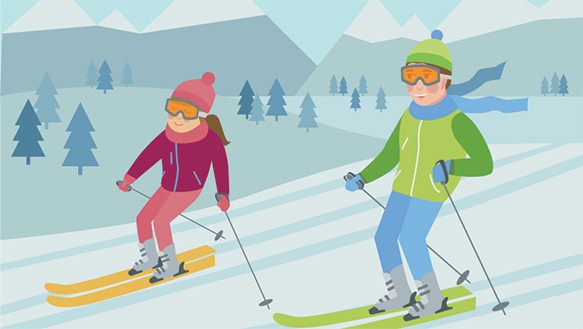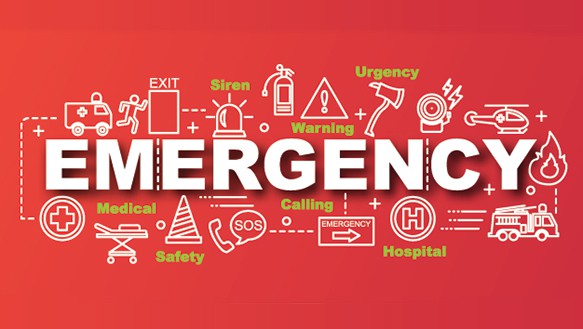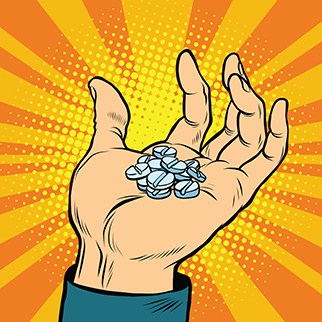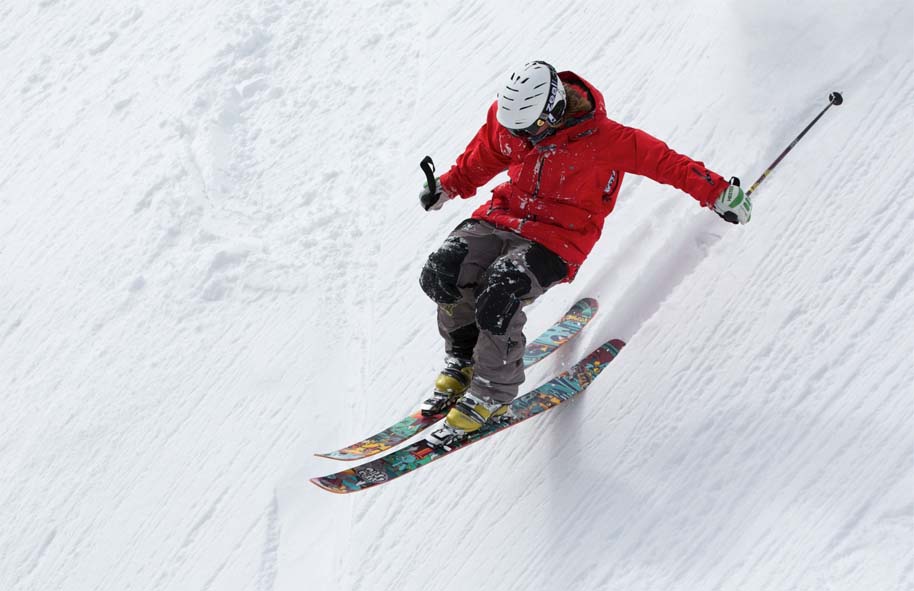
Skiing is not only enjoyable, but it gives one the benefits of moderate to intense aerobic exercise. I grew up on Beech Mountain, in North Carolina, where our family had a condominium. I was called the “snow plow queen”. I would dress up in ski garb to the point of barely being able to walk, and thrust out onto the highest peaks, one aptly named “Sky Dive.”
Often it was pleasant and sunny, barely even cold. These were the best days by far, where you could ski in your jeans, a t-shirt and gators to keep the snow out your boots, with your jacket tied around your waist.
Contents
- Kelly and I skiing on Sugar Mountain
- Benefits of skiing
- How to stay safe while skiing with diabetes
- High altitudes and the effects on diabetes
- Learn how your body reacts to similar exercise and altitudes
- Test your blood sugar levels before, during, and after you ski
- Tips for cold weather
- Your skiing buddy
- What to do in the event of an emergency
- Other things to consider while skiing with diabetes
- Having your meals
- People who ski with diabetes
- Over to you
Kelly and I skiing on Sugar Mountain
My friend Kelly, who had Type 1 diabetes, lived at a time when control of diabetes was harder to achieve. Three years ago, she passed away due to complications related to her Type 1 Diabetes. I think she is one of the main reasons that I became a certified diabetes educator, and decided to raise awareness about diabetes by writing about it.
Kelly loved to ski, but that didn’t come without its consequences. Several times, while skiing on Sugar Mountain, Kelly would have episodes of low blood sugar. She didn’t have a pump, and she was on multiple daily injections at the time. What’s more, she weighed about 90 pounds soaking wet at age 18.
Our friend, Janelle and I were well versed in taking care of Kelly every time she would have a low or a high blood sugar. Her mother made sure that everyone who Kelly went out with knew about her diabetes and the necessary steps to take in case of an emergency.
One time when we set out to hit the slopes of Sugar Mountain on a beautiful, sunny day, with temperatures in the low 50’s, Kelly had eaten breakfast, and everyone had their pockets full of carbohydrates. We were all set. When we hit the slopes, we were having fun, and we were laughing on the lifts, and thumbing down difficult slopes.
When we finally took a break, Kelly was complaining of a headache, and blurred vision. She said she felt tired. She thought her blood sugar might be high this time. She needed to pee. Janelle and I knew exactly what to do for a low blood sugar. We had dealt with that on the ski slopes before, but a high blood sugar wasn’t something that we had dealt with before with Kelly.
We knew we had to check Kelly’s blood sugar, so we got her glucometer out, but the number wouldn’t read. It read “HI,” on the meter. Kelly said that meant she had over a 600 mg/dL blood sugar. At that moment, she remembered that she had done everything thing right for her diabetes self-management except one thing. In the excitement of getting ready, Kelly had forgotten to take her insulin.
We got back to the condominium just in time, and Kelly was able to get a dose of insulin, which helped to bring her blood sugars down. We checked an hour later, and she was down to about 400 mg/dl. She had some moderate ketones, so we called her doctor and he gave her instructions for how much extra insulin she should use. We were pushing fluids and giving her low carbohydrate foods until her blood sugars finally came down.
So, though skiing is a fantastic exercise for diabetes, there are precautions that must be taken to avoid events of high or low blood sugar levels.
The main thing when participating in any sport with diabetes is to be prepared for any emergency that may arise. You should know your body’s limitations, and keep everything that you might possibly need for your diabetes on you, or have your buddy carry the rest for you. That way, you can ensure that you will have a great day out on the slopes.
Benefits of skiing
We know that skiing is a great aerobic exercise. What are the other benefits of skiing for diabetes? For one thing, skiing increases your sensitivity to exogenous insulin that you take if you have Type 1 Diabetes. It increases your sensitivity to the insulin that your body makes, and to any exogenous insulin people with Type 2 Diabetes take.
By being more sensitive to your own insulin, or insulin taken from outside your body, (whether by injections, via an insulin pump, or inhaled insulin), your blood sugars will be controlled. This is great, if you don’t experience a low blood sugar. In order to get the benefits of skiing, you need to be aware of how your body reacts to exercise, whether moderate or intense, and other aerobic exercise, such as skiing. Certain types of skiing are even more strenuous than regular skiing, such as cross-country skiing, or snowboarding.
Skiing helps improve balance. It increases cardiovascular endurance, strengthens bones and joints, lower body muscles. Additionally, just being outside performing an activity helps boosts one’s mood.
If you have severe low or high blood sugars while skiing, then you are defeating the purpose, and not getting the full benefits that skiing provides. We will learn how to avoid those situations, and to stay safe with diabetes while skiing.
How to stay safe while skiing with diabetes
While skiing, you can run into unpredictable situations. A few of the situations you could run into while skiing with diabetes are all related to being isolated, and experiencing a low or high blood sugar.
Here is a list of some of the situations that could arise with your diabetes while skiing:
- You experience a low episode, but the chair life breaks and you have forgotten your extra carbohydrates
- You go low while trying to get on or off the chair lift
- You get so taken away with the beauty of the slopes and engrossed in your skiing outing, that you don’t notice your blood sugar going low
- You take a juice box with you for a low, and it freezes, or you fall on it and crush it
- Your insulin pump, or worse yet, your insulin freezes up in your tubing
- Your glucometer stops working from the cold, just when you need it
- While at high altitudes, you forget to take water to hydrate and your blood sugar has spiked high
- You eat, and pack all your needed diabetes supplied, but due to the excitement of going skiing, you forget to take your insulin or pack any to take on the slopes
- You need to check your blood sugar at the top of the mountain, but your fingers are too cold to get a drop of blood 2
I recommend reading the following articles:
High altitudes and the effects on diabetes
Dehydration, high altitudes, and diabetes
When you have diabetes, you are more likely to become dehydrated due to high blood sugars. Combined with high altitudes, dehydration is highly possible. You will want to hydrate by drinking enough water well prior to skiing, during skiing, and after skiing, so that the high altitude on top of high blood sugars is not a problem for you.
Immersed in the dry mountain air, you may need twice the water to hydrate as you normally drink even when you don’t have diabetes. Therefore, you will need even more water to stay hydrated with diabetes, especially if you experience a high blood sugar while skiing.
Make sure to carry enough water, and refill when you get to the bottom of a slope so that you don’t run out at any point when you might need it. Take time to stop and drink it. Don’t get so caught up in the skiing adventure that you forget to take care of your diabetes. Water bladders that are strapped around your body like a bandolero will work for hydration while skiing, or performing other long-term sporting activities that require you to carry extra water. Get your skiing buddy to carry some extra for you, too.
Altitude sickness and diabetes
If you aren’t used to high altitudes, then you may experience altitude sickness. Once you get used to being at high altitudes, perhaps by skiing more or spending time in the mountains more often, you will not experience altitude sickness. You should also drink more fluids if you experience altitude sickness. Avoid alcohol, because it can cause a nighttime low blood sugar, and its effects are increased with altitudes and altitude sickness due to the dehydration effects of alcohol.
If you know that you are affected by altitude sickness, there is medication that the doctor can prescribe for you ahead of your skiing trip so that you won’t experience it. At high altitudes, you breath more rapidly, and that makes the moisture in your body evaporate more easily, which causes you to become dehydrated. The higher above sea level that you are skiing, the worse the dehydration can be, especially with diabetes.
The symptoms of altitude sickness are listed below, and it’s important to note that fatigue is also present with high blood sugars:
- Loss of appetite, anorexia
- Shortness of breath with little or no exertion
- Fatigue
- Headache
- Difficulty sleeping, and disturbances of sleep
- Rapid breathing
If you get altitude sickness, you should not ski. You should rest, because symptoms are usually worse on the second day, and can last up to a week. Don’t overexert yourself, and eat light meals, so as not to raise your blood sugar too much. If you have episodes of high blood sugar on top of altitude sickness, your symptoms will get worse, and dehydration could be severe. Make sure to hydrate with water, more than double your normal intake. 3
Learn how your body reacts to similar exercise and altitudes
Try taking a short hike and other athletic experiences that put you in high altitudes for a short period of time, so that you can check your blood sugar levels. This will help you to determine how your body reacts to exercises at high altitude for short time periods. Always take a buddy who knows about your diabetes, and can help you in the event that you have a low or high blood sugar.
If you use insulin, checking your blood sugars often during this type of activity will help you to determine if you need to lower your basal and bolus rates. If you take injections, you may need to decrease the amount of basal insulin by 10 to 20 percent. Some people who ski professionally don’t even take mealtime insulin while they ski. That’s due to the high energy they expend, and their wish to avoid a low blood sugar.
It will take some tweaking around to determine how your body will react to skiing. Stress hormones, agitated feelings, and moodiness can all be aggravated by high blood sugars, dehydration, and high altitudes when you ski.
Test your blood sugar levels before, during, and after you ski
When you do decide to try out skiing with diabetes, you want to make sure that you test your blood sugar often. You need to test it before, during, and after you ski. You should carry your glucometer and all your supplies with you, so it is easier for you to test your blood sugars. This will help you to have a good day out skiing, and avoid a severe low or high blood sugar that could ruin a perfectly great day of skiing.
It's true that you can eat large meals, and still bottom out, because skiing can expend a great deal of energy, causing your body to utilize insulin more easily, bringing your blood sugar down. Other people can have problems with high blood sugar during skiing. Everyone is different, and you need to know your body, and your diabetes.
There really is no point in asking another skier with diabetes how they dose their insulin before they hit the slopes, because your insulin needs are different, and unique to you. It’s best to get out there prepared, and start skiing, while checking your blood sugars often, and learning how skiing affects them.
If you have a child who is skiing with diabetes, you will want to check their blood sugar even more often. Children may go low with hardly any insulin while skiing, while their friend with Type 1 diabetes may have sugars out the roof. This is all the more reason to check both of their blood sugars again and again during skiing. Don’t forget the fast-acting carbohydrates! More about good quick-acting carbohydrate choices for skiing with diabetes later, so keep reading. 4
Tips for cold weather
Blood glucose meters and insulin pumps can malfunction at high altitudes. The manufacturer of your glucometer or insulin pump can tell you how high you can take your insulin pump to. The Animas pump is good for up to 20,000 feet, but information on the other pumps are not readily available. Your insulin pump representative should be able to give you this information for your particular pump.
Pumps and tubing should be kept close to the skin, under clothing to keep them warmer, and safe from freezing. Once insulin has frozen, it’s no good, and you will have to disconnect. It’s a great idea to keep insulin pens for backup, but keep them close to your skin as well. If you are extra sensitive to insulin while you are skiing, then you can get insulin pens that give you a half unit of insulin at a time.
If your blood glucose meter becomes effected by altitude, gets cold, and starts giving you erroneous numbers or error messages, you should ski to a lower altitude, or go inside if possible, to warm up a bit. It’s tough to prick your fingers when they are cold, and get a drop of blood. You will need to warm them up, so hit the ski lodge to get toasty by the fire and check your sugar, if possible.
If you are unable to get to the ski lodge at time of the first signs of symptoms of low sugar coming on, then try putting your glucometer under your armpit. That will warm it up in short order, so you can use it. If it still won’t work, and you are having your usual low blood sugar symptoms, treat your blood sugar with quick-acting carbohydrates, ski down the mountain to the ski lodge, warm up, and check your blood sugar again.
Pay attention to your coordination. Often when you are skiing, you aren’t paying attention to your symptoms because you are enjoying the scenery, and concentrating on skiing, and not wiping out. If you are falling a lot, then it’s time to stop and check your blood sugars, to make sure that you are not having a low.
Pick quick-acting carbohydrates that won’t freeze. You can use the glucose gels that can be purchases at outdoor stores. They are great because they don’t freeze. Tuck them into every inside and outside jacket pocket that’s free, so that you have plenty of extra carbohydrates to treat a low blood sugar while skiing. That way, you’ll never find yourself stuck on a chair lift, having a low blood sugar, with no carbohydrates to treat it, which can be a scary feeling!
Wear your medical identification when you are skiing so that if you have an injury, emergency personnel will know that you have diabetes and treat you. You could wear a bracelet on the right wrist, or a military tag style medical ID around your neck. Whatever method you use to identify your diabetes to medical personnel, make sure that they can find it when they need to help you. 3
Your skiing buddy
The number one rule to most activities for people with diabetes is never to ski alone. Always have a buddy, and educate them about how to help you if you were to get into trouble with your blood sugar. For my friend Kelly, I would carry her extra carbohydrates, her extra supplies, and extra fluids. We had a glucagon pen, and we were taught how to use it in the event Kelly was rendered unconscious with a low blood sugar. 5
We always reminded Kelly to take her insulin before she left out on a skiing outing with us, and we also made sure she took her back-up insulin with her.
What to do in the event of an emergency
In an emergency related to diabetes and skiing, remain calm. You are prepared, and you have everything that you need with you because you have read this article. Take your quick-acting carbohydrates if you are having a low blood sugar, ski down the slope, and get to more substantial food. Once you’ve had a low on the slopes, it’s best to call it a day, and try again another day.
If your buddy must help you out of a severely low blood sugar situation that you can’t seem to come up from, and may require emergency attention, they should give you a glucagon injection, and call 911 if you have a cell tower. Don’t leave the person with diabetes on the slope alone. Stay with him or her until help arrives. Other skiers going by may be able to go for help, and there are emergency workers on snow mobiles who can get you down the mountain quickly in the event of a diabetic emergency.
Check in with your doctor before going on extended skiing trips so you can set your basal rate appropriately
Before you take up skiing as a sport, you should make an appointment to see your doctor, and have a talk with them about adjusting your insulin for skiing. The doctor can help you fine tune your insulin doses so you can have a successful skiing experience with diabetes.
If you use an insulin pump, the insulin pump representative or your certified diabetes educator can show you how to adjust your basal and bolus pump rates to account for skiing. You will likely lower your rates 10-20 percent for skiing, but for more vigorous forms of skiing, such as cross-country skiing or snowboarding, you may need to decrease basal and boluses by as much as fifty percent, due to the level of exertion with these winter sports. 6
Other things to consider while skiing with diabetes
Humidity can malfunction glucometers and insulin pumps
Not only can your equipment freeze, but it can also malfunction due to humidity. Skiing through snow machines can cause this, as the snow gets blasted all over you, and then the humidity can get into your equipment. That’s another reason to keep it safely tucked against your body, under several layers of clothing. It’s also best to keep it close to your core, or mid-section, which is near to your heart, and the warmest area of your body.
Your ski outfit should have plenty of pockets with zipper
When you go shopping for ski gear, make sure that you get a ski jacket that has lots of zipper pockets, where you can load up all of your extra glucose gels that won’t freeze up on you in the event you need them for a low blood sugar.
Test before you get on the chairlift
If you don’t test before you get on the chairlift, it could lead to a very dangerous situation. The chair lift comes around fast, and you are standing there waiting on it. You’ve got to have good coordination to make sure that you grab onto it at just the right time, and that you are sitting squarely down in the seat, and can pull the chair lift bar across you, if there is one.
Many chair lifts I have ridden on while skiing in the past have had broken bars, and so there is nothing over you as you hover hundreds of feet in the air, over the hard, snow covered ground. This could be extra dangerous if you have a low blood sugar, and you are trying to coordinate ski poles, chunky skis, and grab onto a chair lift.
Not to mention, you are in slick ski pants most of the time and the chair lifts can break while you are hanging there. One time, I had to sit and wait for them to fix it for three hours. Imagine if you had a severe low blood sugar up there, and you didn’t have any quick-acting carbohydrates. That would be an emergency that would not be easy to come out on the good end of.
Effects of cold and shivering on blood sugars
When you are cold, and you start to shiver, you burn more calories than when you are not cold and shivering. This can cause you to have low blood sugars, so you need to be aware of this while skiing with diabetes. 7
Ensure your glucometer doesn’t freeze, and will work for you while skiing with diabetes
You have a tool at your disposal to warm up your glucometer if it starts to freeze. If you can’t get to the ski lodge to warm it up, then you can take it and put it under your arm. It only takes a few minutes to get it warmed up like this, and it will work correctly again. Keep your glucometer inside your ski jacket, tucked away in a pocket, close to your skin to prevent this problem. Keeping it in a pocket sometimes doesn’t work, and it will get too cold.
Keep your insulin pump away from the cold so it doesn’t freeze
Your skin is always warm, so you want to make sure your pump, and the tubing that goes with it, is kept close to your skin. This will prevent the pump from getting too cold, and it will prevent the insulin inside the tubing from freezing. It’s good to note that if your insulin does freeze, you are going to have to discard it, so take measures to keep it safe from freezing temperatures, and keep your back-ups close to your skin also.
There are special belts for people with diabetes that can be used to attach their pumps next to their skin for freezing temperatures. One such belt is called a Spibelt, and you can find it here: https://spibelt.com/
What about my insulin regimen while I am skiing with diabetes?
If you are going all day and exercising hard, then you may use far less insulin than you normally do when you are not as active. Some professional skiers have found that they don’t need nearly as much insulin. They may even take less than half of their normal dose. Work with your doctor or Certified Diabetes Educator when determining your insulin needs while skiing with diabetes. Some athletes say it is better whey they have more protein and fat, and less carbohydrates for breakfast before they ski.
They will often reduce basal and mealtime insulin doses, and sometimes cutting out mealtime doses altogether. They will eat small, frequent snacks, and try not to eat heavy, carbohydrate meals when they are skiing. These are athletes who know their bodies, and how they will react to exercise.
If you are unsure as to how your body reacts to exercise such as skiing with diabetes, it may be worth to do some pattern management. Check your blood sugars often. Check them at rest, during activity, and try to test them during activities that are similar in intensity to skiing. That way you will better know how your body will react to skiing.
Keep a spare pump and other supplies in a bag on site
Every ski resorts have lockers that you can rent where you can keep a bag of extra supplies on site in case you need them, but which won’t fit in your ski jacket pockets. For example, take a back up glucometer, and a back up insulin pump. Most insulin companies will issue you a loaner vacation pump that you can take with you in case your pump malfunctions.
Skiing with a Continuous Glucose Monitor (CGM)
Having a Continuous Glucose Monitor, or CGM is of great benefit when you are a skier. You won’t have to check your blood sugars as often. You will hear an alarm go off if you are trending low or high blood sugars, and it’s usually ahead of your symptoms. This way you can treat a low before it even becomes a low blood sugar. You can tuck it inside your jacket on the inside, which will keep it warm. You can then glance down at it when you need to know how your blood sugars are doing. It’s much easier to keep track of blood sugars during sports with a CGM.
Ensure your feet are in good condition
If you have problems with circulation in your feet, or if you have nerve damage from diabetes, also known as diabetic neuropathy, then the cold weather, or the uncomfortable ski boots that you must wear to ski may cause damage to your feet. You also wouldn’t want to get frostbites on your toes or fingers.
Visit your doctor, or a podiatrist, to be screened for neuropathies and decreased circulation related to your diabetes before you take up skiing as a sport. You should still be able to get out on the slopes with nerve damage, but you will want to stop if your feet become sore.
It’s best to get your own well-fitting ski boots if you are going to be skiing and have diabetic neuropathy. If you don’t ski enough to purchase your own pair of ski boots, then go to a ski rental shop that fits you for boots. Walk around the shop, and make sure they are not pinching your feet anywhere.
If you have poor circulation, it’s best not to ski during extremely cold weather, due to the increased risk for frostbite from the decreased blood flow to the feet.
Further reading:
Having your meals
Some professional skiers eat light, high protein and fat, but low carbohydrate meals. Others prefer to eat a hearty breakfast, and a meat and potatoes dish for lunch for extra energy while skiing. Many find that their blood sugars may stay low for several days after a particularly strenuous skiing event.
Have extra carbs with you for skiing with diabetes
The best carbohydrates to carry are ones that won’t freeze. You can take glucose gel packs, and stuff them in every pocket, get power energy bars, and gummy bears. Glucose tablets will work just fine, they are smaller to fit in your pocket, the exact right amount of carbohydrates, and they won’t freeze. Liquids such as juice boxes will freeze or burst, so they aren’t the best choices. Lifesavers, peppermints, or other hard candies may also work well.
Hypoglycemia unawareness and skiing
It’s easier to experience hypoglycemia unawareness when you are skiing. It’s so important to check your blood sugars frequently when you are skiing, so as not to let a low blood sugar creep up on you!
People who ski with diabetes
One of the most famous skiers with diabetes is Kris Freeman. Kris has Type 1 Diabetes, and he is a cross country skier, who has competed in three different Winter Olympics. In the last Winter Olympics in Russia, Chris had an “artificial pancreas” combination of an Omnipod insulin pump with a built-in glucometer, and a Dexcom CGM. For back-ups, he carried NovoRapid, an Lantus insulin pens. He started out wearing it on his thigh, but then it got cold, so he moved it to his arm, and that worked out well.
Professional skier tips for skiers with diabetes
During the Olympics, Kris Freeman had to play around with his insulin pump basal rates, but he was able to get them fine-tuned. He had to reduce his basal rates drastically, to about 45 percent of his usual dosage. He later discovered that he had to reduce his basal rate by even more after he finished a cross country event.
Kris had to increase his insulin to carbohydrate ratio, and take less insulin with breakfast, and in peak skiing season, he might have to decrease his total dose by two-thirds due to excess energy expenditure. Trying to keep blood sugars in range on the ski slope can be difficult. Knowing how much pre-meal insulin to take is hard to figure out because if you don’t get it right, then you can have a high blood sugar over 300 mg/dL, and that’s not a good thing while skiing.
Whole grain foods, fatty yogurts (not fat free) and fruit, are some of the high fiber foods that are good to eat for a day of brisk skiing. For Kris, with cross country skiing, and the expenditure of energy required for the sport, if he starts at 200 mg/dL, then he will have some carbohydrates because if he doesn’t, he will end up going low during the long event. For regular skiing, it is not as strenuous as cross-country skiing, so starting with a blood sugar between 140-180 mg/dL should be sufficient to prevent a low.
He always checks his blood sugar prior to start of a cross country event, and that way he knows what he is dealing with before he heads down the slope. It’s a matter of testing frequently, and being aware of your body, in order to be an athlete such as a cross country skier with diabetes.
One tip that Kris offers is that for long events, it may be more practical to switch off an insulin pump, and on to multiple daily injections. 8
From our recent article about people with Type 1 Diabetes who have climbed Mt. Everest, our Type 1 from the US, Will Cross, gave us the tip that you can have two insulin pump sites ready, so that if one fails, you can just switch out to the other one. That was a great tip, and thanks to Will for that.
One good benefit is that you are burning off so much energy, that if you decide to have a treat in the ski lodge, it’s likely that you will have burned it off before you ever sit down to eat it. You can have a few extra carbohydrates, because you will need fuel to propel your skis through the white snow.
Kid’s ski camps for diabetes
Sean Busby is on the board of Juvenile Diabetes Research Foundation, and runs a snowboarding, skiing, camp for kids with diabetes. They hold the camps at different ski resorts, and campers with diabetes can bring one friend with them. The friends will be trained to be a diabetes buddy to help them while skiing. Busby used to be a snowboarder. He was diagnosed with diabetes in his final teenage year, and he almost quit snowboarding at that time.
Instead, he picked himself back up from being knocked down by the diagnosis of his diabetes, and he went back to snowboarding. He and his wife now run the camps all over the world. Campers are ages 7 to 17 years old, and you can sign your child up for their camps by visiting their website here: ridingoninsulin.org. 9
Over to you
We hope you have enjoyed reading our article about skiing with diabetes, and that the tips shared will come in handy when you hit the ski slopes this winter. Make sure you are prepared! Let us know how it went when you return. We always love to hear from you. Share your stories on the topic down below.
TheDiabetesCouncil Article | Reviewed by Dr. Christine Traxler MD on May 20, 2020
References:
- http://www.shesugar.com/diabetes-and-exercise/skiing-safely-type-1-diabetes/
- http://www.diabetes.co.uk/sport/skiing.html
- https://mysugr.com/skiing-insulin-pump/
- http://www.runsweet.com/diabetes-and-sport/skiing/
- https://www.skimag.com/ski-performance/skiing-diabetes
- https://masteringdiabetes.net/2013/12/24/skiing-with-type-1-diabetes/
- https://www.healthline.com/diabetesmine/pro-skier-kris-freeman-ready-for-his-4th-winter-olympics-with-diabetes
- https://www.pugski.com/threads/diabetes-skiing-with-it.2182/
- http://www.ridingoninsulin.org/about-roi.html


